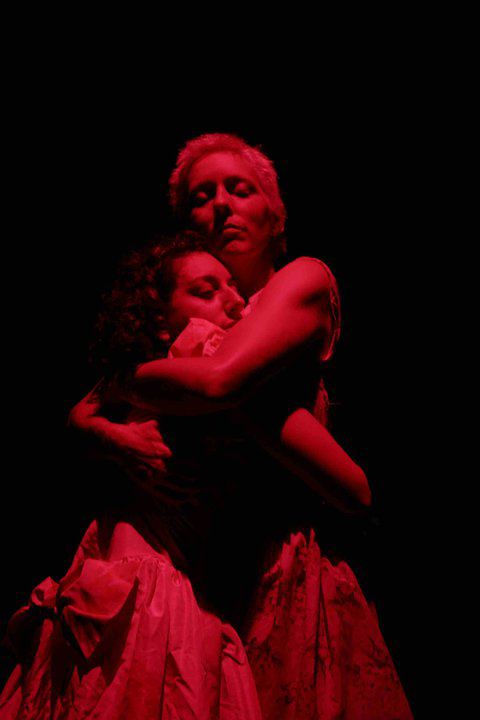TOMBOY BLUES – THE THEORY OF DISAPPOINTMENT BY MARRS.TARRAB
 Have you ever felt a bit different? Have you ever wondered if you really fit into the crowd . . . into your social circle . . . into your own skin even? If you have – then this is a show for you.
Have you ever felt a bit different? Have you ever wondered if you really fit into the crowd . . . into your social circle . . . into your own skin even? If you have – then this is a show for you.
Rachel Mars and nat tarrab have created a performance that examines how it feels to grow up a bit different. In their case, the two characters on stage are tomboys but, in considering this situation, they share something universal with all the different groups in their audience.
247 spoke with them about where the motivations for this work have come from.
There seems to be an assumption in society of masculinity being the baseline from which we all measure ourselves. It’s kind of invisible assuming a guy gets it right but very obvious if he does anything that’s perceived as sissy. Historically, if a woman succeeds in business, politics etc is seems to be because she’s chosen to act in a masculine way but your play seems to find an area where masculine traits are perceived as bad. Would you agree with that?
I think the first distinction to make here is that we’re considering masculinity in terms of boys not men. In these terms, masculinity is all about possibility and playfulness. There are no boundaries in childhood and then tomboyism is seen as acceptable. It’s a bold move on the part of a young girl where she’s not allowing herself to be restrained. She’s testing boundaries and exploring things like power and status. It only starts to become problematic when it continues into adulthood.
When you talk about power and status do you think it’s necessary for an adult woman to take on masculine traits to compete with men? I keep thinking of Margaret Thatcher in the 80s but that’s probably a bad example!!!
There certainly are aspects of adult masculinity that are appealing to us, and women in general. Most of those, hinge around power and family but there aspects of machismo that women seem to be able to incorporate into a sense of style or perhaps attitude.
Performers like Pink?
Yes, she incorporates elements of the tomboy but in ways that her sexuality isn’t in question. That seems to be when tomboyism becomes difficult for people to get their head around. There’s a line in the play that says if a girl continues to be a tomboy in adulthood then she can become a troublesome homosexual.
And that’s where it gets difficult?
Certainly for some people, although it seems that we’ve come into something of a second phase of sexuality. People like Lady Gaga play with all types of sexual identity and there’s a weird reverse kind of thing to tomboyism going on, where four-year-old girls are encouraged, by teen idols, to dress up in high heels and make up. All these “rules” that have always been in place are being revisited in lots of different ways.
Speaking of rules, I think it was particularly effective how you portrayed the scientific discourse in the play. Is it particular to this show?
We’ve always been interested in authorative voices which think that they’ve got a line on absolute truth. That’s why we put on the white coats to give them their say in the show . . . to ultimately prove that anyone who thinks they know it all . . . really don’t. We used to refer to them in rehearsals as “they who know” but now we just talk about “they”. We’re really interested in minorities in identity – which in one way or another is probably all of us! That’s what seems to give us the best connection to the audience.
Do you find it works for everyone?
The feedback that we’ve had seems to suggest that the more deeply truthful and honest we are, about ourselves and our own identities, the more all the different facets of the audience seem to connect to it. We’ve had middle aged, middle class men saying they could relate to that feeling. It’s quite unexpected but lovely. The show’s a real heartfelt piece coming from the two of us. We’ve worked on it for so long we probably couldn’t even tell you which aspects came from each of us . . . but it all comes from a place of truth.
Speaking of which, when we talked before you said how you didn’t want it being just a queer play and it certainly sounds like it’s not. Having said that though, in it’s most traditional sense, Queer Theory talks of “othering” yourself to a situation so that you can truly see it for what it is. I think Tomboy Blues certainly works on that level.
Thank you. You’re right we didn’t want a play that just spoke to a queer audience, we wanted something a bit more universal but the notions of queer certainly work here in terms of those who are in minorities of identity. Anyone who’s ever struggled at all with his or her place in the world will, we hope, find something here. There’s been much discussion about how far the two characters on the stage are us . . . and if they are really in love. The play starts by considering if this is a love story but we wanted to show that the only way to begin is to love yourself and sometimes, to do that, you need to look at yourself through the eyes of another . . . or an audience . . . or just take a step back from everything you’ve ever been told and really consider who you are. In that context, queering yourself works completely.
So you’re hoping to take this show into schools to give kids a better sense of diversity but what truths do you think it holds for a member of the 247 audience? As young adults, in their late teens or early twenties, what would then take from this show?
I think the only answer we can give you there is, that sometimes you’ll be out on the street and you’ll see someone who doesn’t seem to fit in the crowd she’s with. There are all sorts of acceptable ways to be “alternative” these days with people choosing to be “emo” or whatever other sense of style they relate to but I still think our society can be “lookist”. Some people just seem a little uncomfortable in their own skin . . . and when I see that person I just want to run across the street and hug her and tell her she’s okay. That’s really what this play is about . . . us reaching out to people to say we’re okay and that you are too.
If you didn’t catch “Tomboy Blues” at the Barbican Theatre in March then there’s still time. It’s next appearing on 1st & 2nd July as part of The Exeter Fringe at The Phoenix Theatre. From there it will be at The Nightingale Theatre, Brighton on 29th & 30th July before heading up to the Edinburgh Fringe Festival for two weeks from 14th-29th August at Zoo Southside.



